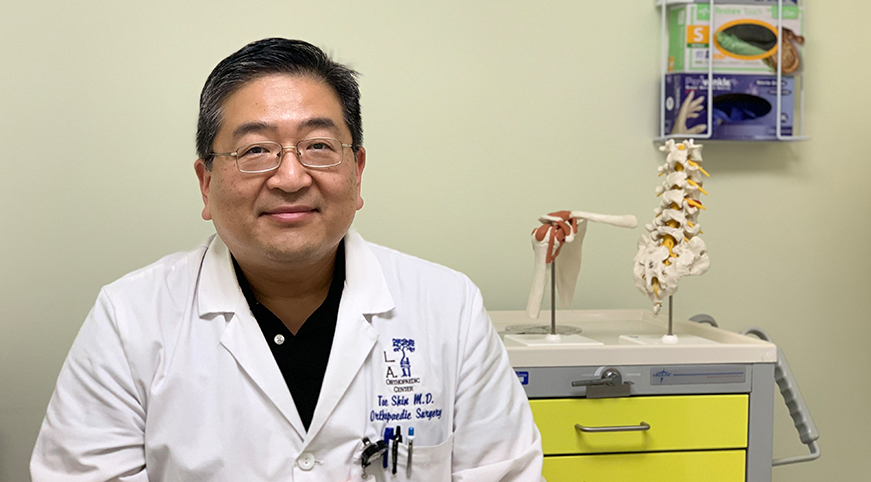Tae Shin, MD, is a board-certified orthopedic surgeon specializing in spine surgery and general orthopedics at CHA HPMC.
Tell us about your background and specialty.
I earned my medical degree from Yale University School of Medicine and completed my orthopedic residency training at the State University of New York at Brooklyn and a Spine Surgery Fellowship at New England Baptist Medical Center in Boston. I was a Clinical Professor of Orthopedic Surgery at Tufts University School of Medicine in Boston and went on to join the Los Angeles Orthopedic Center (LAOC). I’ve been practicing since 1999. While I started my career focusing on spine surgeries, I expanded my knowledge and practice to include hip and knee replacement surgeries after getting acquainted with a renowned surgeon in Koreatown. I’ve had a longstanding association with CHA HPMC and have been practicing here intermittently for over 15 years. After the closure of St. Vincent Medical Center, I moved my office back to HPMC in the Doctors Tower.
What are your areas of specialty and what type of surgical services do you offer at CHA HPMC?
I specialize in the operative and non-operative treatment of spinal disorders. I also perform hip and knee replacement surgeries. Some of the surgeries I perform include:
- Lumbar laminectomy for stenosis treatment
- Lumbar fusion for spinal spondylolisthesis
- Minimally invasive microdiscectomy
- Minimally invasive techniques for spinal fusion
- Cervical discectomy and fusion surgeries
- Kyphoplasty for spinal fractures
- Treatment of deformities of the spine
- Total knee replacement with computer navigation
- Robotic partial knee replacements
- Total hip replacement with computer navigation
- Treatment of fractures of arms and legs
Tell us about the minimally invasive surgeries you perform.
- Kyphoplasty: Kyphoplasty is a minimally invasive surgery used to treat a spinal fracture. Osteoporosis, a condition which causes the bones to become weak, is common among elderly adults — more so in Korean elderly adults. The condition weakens the spinal vertebrae and causes spinal compression fractures. Through Kyphoplasty, we can reduce pain, stabilize and restore the vertebra. Kyphoplasty is an outpatient procedure. The patient is under sedation, but not general anesthesia. A needle is carefully placed on to the spine bone that is fractured. A specialized cement is injected into the fracture site which hardens in 15 minutes. The patient stays on the operating table while the cement hardens. Most patients can go home the same day as the procedure. Usually, the pain reduces by 70% within the next 24 hours. I am one of the top surgeons (by volume) in LA performing minimally invasive treatment for spine fractures among the elderly population.
- Minimally invasive lumbar surgeries: Lumbar microdiscectomy is performed to remove a herniated or generated disc in the lower spine. The surgery is performed in a minimally invasive manner. Rather than a big incision to access the disc, we use a small incision to reach the herniated disc. Special retractors, like circular tubes, are used to spread the muscle apart rather than cutting through them. By spreading the muscles, there is limited scope of injury to the muscles and soft tissues. Therefore, the muscles heal quicker with less pain. This technique can also be performed for lumbar fusions as well with smaller incisions for placement of screws when necessary.
What are some of the benefits of minimally invasive procedures?
Some of the important benefits are:
- Quicker recovery for the patients
- Lower risk of complications such as infections and blood loss
- Some procedures can be performed under sedation rather than general anesthesia
- Reduced length of stay at the hospital
What is your patient care philosophy?
I believe in conservative (non-surgical) treatment for orthopedic conditions. I always tell my patients that surgery is an option, but it should be the last option. The percentage of people needing surgery is minor. There are multiple ways to treat orthopedic conditions and other methods can produce the same positive result as surgery.
Go to our Blog
 ENGLISH
ENGLISH KOREAN
KOREAN Spanish
Spanish RUSSIAN
RUSSIAN Armenian
Armenian FILIPINO
FILIPINO Chinese (Simplified)
Chinese (Simplified) Chinese (Traditional)
Chinese (Traditional)

최신댓글